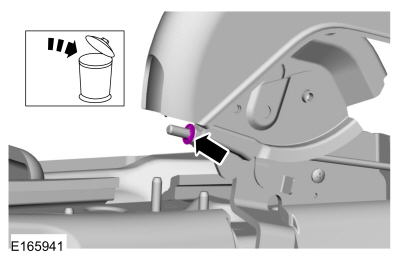Ford Fiesta: Tire Pressure Monitoring System (TPMS) / Tire Pressure Monitoring System (TPMS). Diagnosis and Testing
DTC Charts
Diagnostics in this manual assume a certain skill level and knowledge of Ford-specific diagnostic practices.
REFER to: Diagnostic Methods (100-00 General Information, Description and Operation).
BCM DTC Chart
| DTC | Description | Action |
|---|---|---|
| B1182:00 | Tire Pressure Monitoring System: No Sub Type Information | GO to Pinpoint Test A |
| B1182:55 | Tire Pressure Monitoring System: Not Configured | GO to Pinpoint Test G |
| B124D:02 | Tire Pressure Sensor: General Signal Failure | GO to Pinpoint Test B |
| B1254:51 | Right Rear (Outside on Dual Wheel) Tire Pressure Sensor and Transmitter Assembly: Not Programmed | GO to Pinpoint Test G |
| B1255:51 | Left Rear (Outside On Dual Wheel) Tire Pressure Sensor and Transmitter Assembly: Not Programmed | GO to Pinpoint Test G |
| C1A56:51 | Left Front Tire Pressure Sensor and Transmitter Assembly: Not Programmed | GO to Pinpoint Test G |
| C1A58:51 | Right Front Tire Pressure Sensor and Transmitter Assembly: Not Programmed | GO to Pinpoint Test G |
| — | All Other BCM Diagnostic Trouble Codes (DTCs) |
REFER to: Body Control Module (BCM) (419-10 Multifunction Electronic Modules, Diagnosis and Testing). |
Symptom Charts
Symptom Chart: Tire Pressure Monitoring System
Diagnostics in this manual assume a certain skill level and knowledge of Ford-specific diagnostic practices.
REFER to: Diagnostic Methods (100-00 General Information, Description and Operation).
Symptom Chart
| Condition | Possible Sources | Actions |
|---|---|---|
| A module does not respond to the diagnostic scan tool |
|
REFER to: Communications Network (418-00 Module Communications Network, Diagnosis and Testing). |
| The TPMS warning indicator is on continuously and the message center displays LOW TIRE PRESSURE |
|
GO to Pinpoint Test D |
| The BCM will not enter TPMS sensor training mode |
|
GO to Pinpoint Test E |
| The TPMS warning indicator is never or always on |
|
REFER to: Instrumentation, Message Center and Warning Chimes (413-01 Instrumentation, Message Center and Warning Chimes, Diagnosis and Testing). |
| One or more TPMS sensors do not train and no Diagnostic Trouble Codes (DTCs) are present |
|
GO to Pinpoint Test F |
Pinpoint Tests
 PINPOINT TEST A: B1182:00
PINPOINT TEST A: B1182:00|
NOTE: Make sure all aftermarket electronic equipment has been disconnected (if possible) and the customer has been questioned about the electronic equipment they may have been using in the vehicle when this concern was identified. Normal Operation and Fault Conditions
REFER to: Tire Pressure Monitoring System (TPMS) - System Operation and
Component Description (204-04B Tire Pressure Monitoring System (TPMS),
Description and Operation). The TPMS communication can be interrupted by RFI , which can cause intermittent issues that are not vehicle concerns. RFI is generated by electrical motors and appliance operation, cellular telephones, remote transmitters, power inverters and portable entertainment equipment. DTC Fault Trigger Conditions
Possible Sources
Visual Inspection and Pre-checks
|
||||||
| A1 CHECK THE COMMUNICATION NETWORK | ||||||
Does the BCM pass the Network Test?
|
||||||
| A2 TRAIN THE TPMS (TIRE PRESSURE MONITORING SYSTEM) SENSORS | ||||||
Did all of the TPMS sensors transmit correctly and did the horn sound when each sensor transmitted to the BCM ?
|
||||||
| A3 REPEAT THE TPMS (TIRE PRESSURE MONITORING SYSTEM) TRAINING | ||||||
|
NOTE: Make sure that all aftermarket electronic equipment has been disconnected (if possible) and the customer has been questioned about the types of electronic equipment they may have been using in the vehicle when this issue was identified.
Did any of the TPMS sensors train and did the horn sound when each sensor transmitted to the BCM ?
|
||||||
| A4 CHECK FOR CORRECT BCM (BODY CONTROL MODULE) OPERATION | ||||||
Is the concern still present?
|
 PINPOINT TEST B: B124D:02
PINPOINT TEST B: B124D:02|
Normal Operation and Fault Conditions The TPMS sensor radio transmissions are sent to the BCM approximately once every 60 seconds while the vehicle speed exceeds 32 km/h (20 mph). The TPMS sensor communication to the BCM can be interrupted by RFI , which can cause intermittent issues that are not vehicle concerns. RFI is generated by items such as; electrical motors and appliance operation, cellular telephones, remote transmitters, power inverters and portable entertainment equipment. When the TPMS sensor training procedure is performed successfully, the warning indicator is extinguished and the vehicle must be driven for 18-20 minutes before the BCM sets a fault. DTC Fault Trigger Conditions
Possible Sources
Visual Inspection and Pre-checks
|
||||||
| B1 ACTIVATE THE TPMS (TIRE PRESSURE MONITORING SYSTEM) SENSORS AND CHECK FOR BCM (BODY CONTROL MODULE) DIAGNOSTIC TROUBLE CODES (DTCS) | ||||||
Is DTC B1182:00 present?
|
||||||
| B2 CARRY OUT THE TPMS (TIRE PRESSURE MONITORING SYSTEM) SENSOR TRAINING PROCEDURE | ||||||
Did all of the TPMS sensors train successfully and did the horn sound when each TPMS sensor transmitted to the BCM ?
|
||||||
| B3 ATTEMPT TO TRAIN THE TPMS (TIRE PRESSURE MONITORING SYSTEM) SENSORS AGAIN | ||||||
Did any of the TPMS sensors train successfully and did the horn sound when each TPMS sensor transmitted to the BCM ?
|
||||||
| B4 CHECK FOR CORRECT BCM (BODY CONTROL MODULE) OPERATION | ||||||
Is the concern still present?
|
 PINPOINT TEST C: DIAGNOSING RADIO FREQUENCY INTERFERENCE FAULTS
PINPOINT TEST C: DIAGNOSING RADIO FREQUENCY INTERFERENCE FAULTS|
Normal Operation and Fault Conditions When the TPMS sensor is activated by the sensor training tool, the sensor transmits the current tire pressure and sensor identification to the BCM . RFI or a sensor with an internal failure prevents the sensor from transmitting the information to the BCM . Likewise, a BCM with an internal failure prevents the sensor information from reaching the BCM . Possible Sources
Visual Inspection and Pre-checks
|
||||
| C1 VIEW THE BCM (BODY CONTROL MODULE) TIRE PRESSURE MONITORING SYSTEM STATUS (TPMS_STAT) PID (PARAMETER IDENTIFICATION) | ||||
Does the BCM TPMS_STAT PID display SYSTEM FAULT?
|
||||
| C2 CARRY OUT THE TPMS (TIRE PRESSURE MONITORING SYSTEM) SENSOR TRAINING PROCEDURE | ||||
|
NOTE: Before beginning TPMS sensor training, make sure the vehicle is away from other vehicles or devices that might cause RFI such as electric motors or radio transmitters.
Did all of the TPMS sensors transmit correctly and did the horn sound when each sensor transmitted to the BCM ?
|
||||
| C3 ATTEMPT TO CARRY OUT THE SENSOR TRAINING PROCEDURE AGAIN USING KNOWN GOOD SENSORS | ||||
Did the known good TPMS sensors transmit correctly and did the horn sound when the known good TPMS sensors transmitted to the BCM ?
|
||||
| C4 CHECK FOR CORRECT BCM (BODY CONTROL MODULE) OPERATION | ||||
Is the concern still present?
|
 PINPOINT TEST D: THE TPMS (TIRE PRESSURE MONITORING SYSTEM)
WARNING INDICATOR IS ON CONTINUOUSLY AND THE MESSAGE CENTER DISPLAYS LOW TIRE PRESSURE
PINPOINT TEST D: THE TPMS (TIRE PRESSURE MONITORING SYSTEM)
WARNING INDICATOR IS ON CONTINUOUSLY AND THE MESSAGE CENTER DISPLAYS LOW TIRE PRESSURE|
Normal Operation and Fault Conditions The BCM monitors the tire pressure of all 4 road tires. The wheel-mounted tire pressure sensors transmit data via radio frequency signals to the BCM where a predetermined pass/fail criteria is applied. The TPMS sensor radio transmissions are sent approximately once every 60 seconds while the vehicle speed exceeds 32 km/h (20 mph). The BCM compares each TPMS sensor transmission against a low-pressure limit. If it has been determined that the tire pressure has fallen below this limit, the BCM communicates this on the MS-CAN to the IPC . The IPC then illuminates the TPMS warning indicator and displays the appropriate message in the message center. For vehicles with different front and rear tire pressures, the tire
pressures must be adjusted and the TPMS sensors must be trained
following a tire rotation. REFER to: Tire Pressure Monitoring System
(TPMS) Sensor Location Calibration (204-04B Tire Pressure Monitoring
System (TPMS), General Procedures). For vehicles with the same front and rear tire pressures, tire rotation does not affect the TPMS . Possible Sources
Visual Inspection and Pre-checks
|
||||
| D1 CHECK FOR SPARE TIRE IN USE | ||||
Is the spare tire in use?
|
||||
| D2 CHECK FOR LOW TIRE PRESSURE | ||||
Has the TPMS warning indicator gone out?
|
||||
| D3 TRAIN ALL 4 TPMS (TIRE PRESSURE MONITORING SYSTEM) SENSORS | ||||
Do all of the TPMS sensors train?
|
||||
| D4 CHECK THE TIRE PRESSURES USING THE BCM (BODY CONTROL MODULE) TIRE PRESSURE PARAMETER IDENTIFICATIONS (PIDS) | ||||
Do the Left Front (LF), Right Front (RF) and Left Rear (LR) tire pressures indicated by the Parameter Identifications (PIDs) match the tire pressures shown by special tool 204-354, ±20.7 kPa (3 psi)?
|
 PINPOINT TEST E: THE BCM (BODY CONTROL MODULE)
WILL NOT ENTER TPMS (TIRE PRESSURE MONITORING SYSTEM)
SENSOR TRAINING MODE
PINPOINT TEST E: THE BCM (BODY CONTROL MODULE)
WILL NOT ENTER TPMS (TIRE PRESSURE MONITORING SYSTEM)
SENSOR TRAINING MODE|
Normal Operation and Fault Conditions For the BCM to enter TPMS sensor training mode, the BCM must receive valid inputs from the stoplamp switch (off) and ignition (ON), and it must receive valid vehicle speed sensor input (0 km/h [0 mph]). If the vehicle has been stationary for more than 15 minutes, the
TPMS
sensors go into a sleep mode to conserve battery power. It becomes
necessary to wake them up so they transmit the latest tire pressure
information to the BCM . REFER to: Tire Pressure Monitoring System
(TPMS) Sensor Activation (204-04B Tire Pressure Monitoring System
(TPMS), General Procedures). Possible Sources
Visual Inspection and Pre-checks
|
||||
| E1 CHECK THE BCM (BODY CONTROL MODULE) IGNITION INPUT | ||||
Does the PID indicate the correct ignition state?
|
||||
| E2 CHECK FOR VEHICLE SPEED-RELATED DIAGNOSTIC TROUBLE CODES (DTCS) IN THE PCM (POWERTRAIN CONTROL MODULE) | ||||
Are there any vehicle speed-related Diagnostic Trouble Codes (DTCs) present in the PCM ?
|
||||
| E3 CHECK THE STOPLAMP OPERATION | ||||
Do the stoplamps operate correctly?
|
||||
| E4 CHECK FOR CORRECT BCM (BODY CONTROL MODULE) OPERATION | ||||
Is the concern still present?
|
 PINPOINT TEST F: ONE OR MORE TPMS (TIRE PRESSURE MONITORING SYSTEM)
SENSORS DO NOT TRAIN AND NO DIAGNOSTIC TROUBLE CODES (DTCS) ARE PRESENT
PINPOINT TEST F: ONE OR MORE TPMS (TIRE PRESSURE MONITORING SYSTEM)
SENSORS DO NOT TRAIN AND NO DIAGNOSTIC TROUBLE CODES (DTCS) ARE PRESENT|
Normal Operation and Fault Conditions The BCM monitors the tire pressure of all 4 road tires. The wheel-mounted tire pressure sensors transmit signals via radio frequency to the BCM . The BCM is a radio receiver that collects the tire pressure data from the tire pressure sensors. The TPMS sensor radio transmissions are sent once approximately every 60 seconds when the vehicle speed exceeds 32 km/h (20 mph). Through the training process, the BCM learns the position of each TPMS sensor. If the vehicle has been stationary for more than 15 minutes, the
TPMS
sensors go into a sleep mode to conserve battery power. It becomes
necessary to wake them up so they transmit the latest tire pressure
information to the BCM . REFER to: Tire Pressure Monitoring System
(TPMS) Sensor Activation (204-04B Tire Pressure Monitoring System
(TPMS), General Procedures). Possible Sources
Visual Inspection and Pre-checks
|
||||
| F1 ATTEMPT TO TRAIN THE TPMS (TIRE PRESSURE MONITORING SYSTEM) SENSORS | ||||
|
NOTE: The BCM has a 2-minute time limit between sensor responses. If the BCM does not recognize any of the 4 TPMS sensors during this time limit, the horn sounds twice and the message center displays TIRE NOT TRAINED REPEAT. The entire procedure must be repeated.
Do all of the TPMS sensors train?
|
||||
| F2 CHECK FOR RADIO FREQUENCY INTERFERENCE (RFI) | ||||
Did all 4 of the TPMS sensor train?
|
 PINPOINT TEST G: B1182:55, B1254:51, B1255:51, C1A56:51 OR C1A58:51
PINPOINT TEST G: B1182:55, B1254:51, B1255:51, C1A56:51 OR C1A58:51|
DTC Fault Trigger Conditions
Possible Sources
|
||||||||||||||||||
| G1 CHECK VEHICLE HISTORY | ||||||||||||||||||
Were there any recent BCM service actions?
|
||||||||||||||||||
| G2 CARRY OUT THE TPMS SENSOR TRAINING PROCEDURE | ||||||||||||||||||
Are there any BCM Diagnostic Trouble Codes (DTCs) present?
|
||||||||||||||||||
| G3 PROGRAM THE BCM | ||||||||||||||||||
Are there any BCM Diagnostic Trouble Codes (DTCs) present?
|
 Tire Pressure Monitoring System (TPMS) Sensor Activation. General Procedures
Tire Pressure Monitoring System (TPMS) Sensor Activation. General Procedures
Special Tool(s) /
General Equipment
204-D081A
(204-D081)
Tire Pressure Monitor (TPMS)
Activation
NOTE:
The tire pressure sensors will go into a "sleep
mode" when a vehicle is stationary to conserve battery power...
Other information:
Ford Fiesta 2014 - 2019 Service Manual: Information and Entertainment System - System Operation and Component Description. Description and Operation
System Operation System Diagram Network Message Chart A missing network message is indicated by a U-code DTC and can be the result of intermittent concerns such as damaged wiring or low battery voltage occurrences. Additionally, vehicle repair procedures such as module reprogramming can set these Diagnostic Trouble Codes (DTCs)...
Ford Fiesta 2014 - 2019 Service Manual: Fuel Tank Filler Pipe. Removal and Installation
Special Tool(s) / General Equipment Hose Clamp(s) Removal NOTE: Removal steps in this procedure may contain installation steps. With the vehicle in NEUTRAL, position it on a hoist. Refer to: Jacking and Lifting - Overview (100-02 Jacking and Lifting, Description and Operation)...
Categories
- Manuals Home
- Ford Fiesta Service Manual (2014 - 2019)
- Maintenance Schedules
- Engine System - General Information
- Engine Component View. Description and Operation
- Clutch - 6-Speed Manual Transmission – B6
- Front Suspension
Parking Brake Control. Removal and Installation
Removal
NOTE: Removal steps in this procedure may contain installation details.
Remove the floor console.Refer to: Floor Console (501-12 Instrument Panel and Console, Removal and Installation).
Remove the driver seat.
Refer to: Front Seat (501-10 Seating, Removal and Installation).
Remove the parking brake cable adjustment lock nut.
 Loosen the parking brake cable adjustment nut.
Loosen the parking brake cable adjustment nut.

 PINPOINT TEST A: B1182:00
PINPOINT TEST A: B1182:00